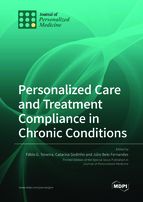Personalized Care and Treatment Compliance in Chronic Conditions
A special issue of Journal of Personalized Medicine (ISSN 2075-4426). This special issue belongs to the section "Methodology, Drug and Device Discovery".
Deadline for manuscript submissions: closed (25 February 2022) | Viewed by 56909
Special Issue Editors
Interests: regenerative medicine; mesenchymal stem cells; stem cells secretome; bioreactor cell culture; exosomes; astrocyte reactivity; neuron-glia communication; 3D culture systems; Parkinson's disease
Special Issues, Collections and Topics in MDPI journals
Interests: neurological diseases; Parkinson's disease; elderly and aging; clinical exercise; non-pharmacologic interventions
Special Issues, Collections and Topics in MDPI journals
Interests: nursing; personalized medicine; physical rehabilitation; neurorehabilitation; qualitative research; health promotion
Special Issues, Collections and Topics in MDPI journals
Special Issue Information
Dear Colleagues,
Background: Chronic diseases such as diabetes, cancer, cardiovascular and neurodegenerative diseases are growing at an alarming rate, especially in the aging population. People who have chronic disease spend a significant amount of time in self-management in out-of-hospital environments, in their homes and in their community settings. These patients have different disease statuses and management requirements, so providing personalized care is key.
Aim and scope: We aim to publish articles describing a personalized care approach to the diagnosis and treatment to chronically ill patients.
History: Personalised care is a collaborative process that should be used in chronic condition management in which patients, caregivers and healthcare providers identify and discuss problems caused by or related to the patient's condition, and then develop plans and goals to empower patients.
Cutting-edge research: Personalized care can improve aspects of physical health, mental health and the ability to self-manage conditions. Thus, a personalized care approach could greatly benefit patients with chronic conditions.
What kind of papers we are soliciting: We encourage the submission of manuscripts that describe a personalized care approach to the diagnosis and treatment to chronically ill patients.
Dr. Fábio G. Teixeira
Dr. Catarina Godinho
Prof. Dr. Júlio Belo Fernandes
Guest Editors
Manuscript Submission Information
Manuscripts should be submitted online at www.mdpi.com by registering and logging in to this website. Once you are registered, click here to go to the submission form. Manuscripts can be submitted until the deadline. All submissions that pass pre-check are peer-reviewed. Accepted papers will be published continuously in the journal (as soon as accepted) and will be listed together on the special issue website. Research articles, review articles as well as short communications are invited. For planned papers, a title and short abstract (about 100 words) can be sent to the Editorial Office for announcement on this website.
Submitted manuscripts should not have been published previously, nor be under consideration for publication elsewhere (except conference proceedings papers). All manuscripts are thoroughly refereed through a single-blind peer-review process. A guide for authors and other relevant information for submission of manuscripts is available on the Instructions for Authors page. Journal of Personalized Medicine is an international peer-reviewed open access monthly journal published by MDPI.
Please visit the Instructions for Authors page before submitting a manuscript. The Article Processing Charge (APC) for publication in this open access journal is 2600 CHF (Swiss Francs). Submitted papers should be well formatted and use good English. Authors may use MDPI's English editing service prior to publication or during author revisions.
Keywords
- personalized care
- person-centredness
- patient compliance
- patient participation
- empowerment
- chronic conditions
- chronic disease









